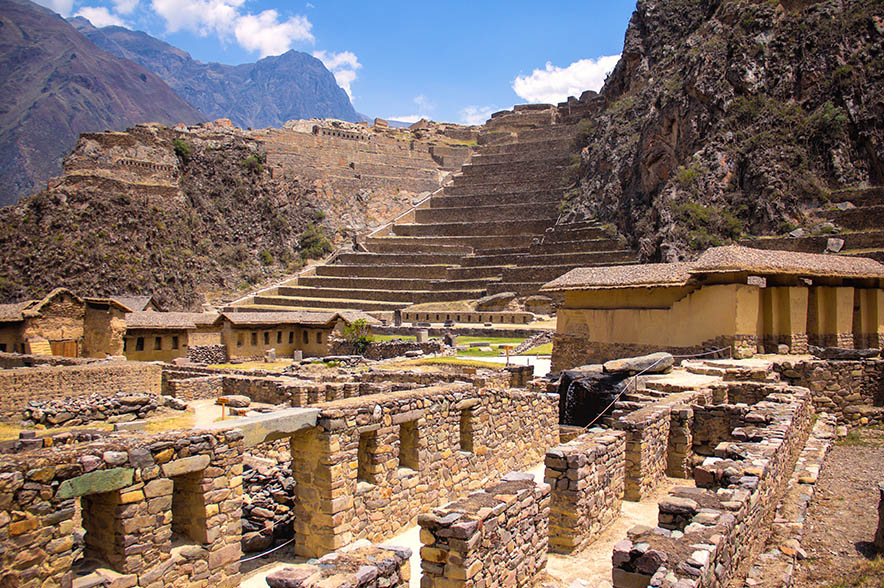The Ollantaytambo ruins are a significant archaeological site in Peru, offering a captivating blend of history, Inca engineering prowess, and breathtaking scenery. Here’s a detailed and expanded guide covering all you need to know about the Ollantaytambo ruins:
1. Historical Significance:
- Inca Fortress: Ollantaytambo served as both a ceremonial center and a military fortress during the Inca Empire. The site played a strategic role in defending against potential invasions from the Amazon jungle.
- Construction Period: The construction of Ollantaytambo began during the late 15th century and was later expanded by Emperor Pachacuti during the 15th century.
2. Geographical Location:
- Sacred Valley: Ollantaytambo is situated in the Sacred Valley of the Incas, approximately 60 kilometers northwest of Cusco. The town of Ollantaytambo is part of the larger archaeological complex that includes religious, administrative, and residential areas.
- Strategic Position: The location of Ollantaytambo has strategic significance as it controls the entrance to the Sacred Valley and serves as a gateway to Machu Picchu.
3. Inca Architecture:
- Terraced Agricultural Complexes: The ruins feature impressive agricultural terraces, a hallmark of Inca engineering. These terraces served both practical and religious purposes, showcasing the Incas’ mastery of agricultural techniques in mountainous terrain.
- Temples and Religious Structures: Explore the Temple of the Sun, a massive ceremonial structure made of enormous stones. The site also includes the Wall of the Six Monoliths and the Princess Baths, demonstrating the precision with which the Incas cut and transported massive stones.
4. Temple of the Sun:
- Architectural Marvel: The Temple of the Sun is one of Ollantaytambo’s most remarkable structures. It features massive stone blocks, some weighing over 50 tons, arranged with incredible precision.
- Intihuatana: Like Machu Picchu, Ollantaytambo has an Intihuatana, a ritual stone associated with astronomy and the calendar. The Intihuatana at Ollantaytambo is believed to have played a role in religious ceremonies and agricultural practices.
5. Urban Planning and Water Engineering:
- Street Layout: Ollantaytambo’s urban layout is characterized by narrow cobblestone streets and well-planned architecture. The town’s design reflects Inca concepts of urban planning and organization.
- Water Channels: The site features an intricate network of water channels that provided fresh water to the residents. The Incas were highly skilled in hydraulic engineering, and the water features at Ollantaytambo showcase their mastery.
6. Transportation Hub:
- Terraced Platforms: The terraced platforms on the eastern side of Ollantaytambo served as a ceremonial area and also functioned as a stopping point for travelers along the Inca Trail.
- Gateway to Machu Picchu: Ollantaytambo is a starting point for the Inca Trail, a famous trek that ultimately leads to Machu Picchu. Travelers often explore Ollantaytambo before embarking on the trek to Machu Picchu.
7. Defensive Features:
- Terraced Hillside: The terraced hillside of Ollantaytambo served both agricultural and defensive purposes. The stepped terraces were designed to slow down invaders and provide the defending forces with an advantageous position.
- Military Structures: Explore the military structures and defensive walls, which include the “Temple Hill” complex. The strategic placement of these structures reflects the Inca military’s ability to incorporate natural features into their defense systems.
8. Ollantaytambo Today:
- Living Inca Town: Ollantaytambo is not just an archaeological site; it’s a living Inca town. Visitors can experience the unique charm of the town, characterized by its well-preserved Inca and colonial architecture.
- Tourist Destination: Ollantaytambo is a popular destination for tourists exploring the Sacred Valley. It’s often visited before or after the journey to Machu Picchu, as it provides a glimpse into both ancient and colonial history.
9. Access and Entrance Fees:
- Entrance Fee: To visit the archaeological site of Ollantaytambo, visitors usually need to purchase a tourist ticket, which also grants access to other sites in the Sacred Valley. The ticket is available for purchase in Cusco or at the entrance to Ollantaytambo.
- Guided Tours: While exploring Ollantaytambo independently is possible, guided tours are available and recommended for a deeper understanding of the historical and cultural significance.
10. Best Time to Visit:
- Dry Season: The dry season, from May to October, is considered the best time to visit Ollantaytambo. During this period, the weather is generally clear, and the site is more accessible.
- Festivals: Consider timing your visit to coincide with local festivals, such as the Ollantay Raymi celebration in January, which includes traditional dances, processions, and cultural events.
11. Practical Tips:
- Comfortable Footwear: Wear comfortable and sturdy footwear as you explore the uneven terrain and steep steps of the archaeological site.
- Sun Protection: The high-altitude sun can be intense. Bring sunscreen, a hat, and sunglasses to protect yourself from the sun.
- Hydration: Carry water to stay hydrated, especially if you plan to explore the site for an extended period.
- Respectful Behavior: Show respect for the historical site by not climbing on the structures or touching the ancient stones. Follow guidelines provided by guides or signage.
12. Connecting with Nearby Sites:
- Moray: Combine your visit to Ollantaytambo with a trip to Moray, an archaeological site featuring circular agricultural terraces.
- Maras: Explore the Maras salt mines, known for their intricate salt pans, which can be visited on the way to or from Ollantaytambo.
In conclusion, Ollantaytambo stands as a testament to the ingenuity and architectural prowess of the Inca civilization. Whether you’re fascinated by ancient history, interested in Inca engineering, or seeking a picturesque town with a rich cultural heritage, Ollantaytambo offers a compelling destination within the heart of the Sacred Valley.

